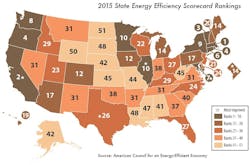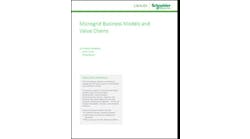2015 ACEEE State Energy Efficiency Scorecard: 20 States Rise and Massachusetts Reigns – But Just Barely
For the fifth year, Massachusetts has earned a #1 ranking on the American Council for an Energy-Efficient Economy (ACEEE)’s State Energy Efficiency Scorecard, scoring 44 out of a possible 50 points. California, hot on the winner’s trail, was only half a point behind.
Released earlier this week, the State Energy Efficiency Scorecard analyzes state energy efficiency policies and program efforts, offering recommendations for ways to improve.
It seems a little healthy competition is indeed a good thing. According to the ACEEE, savings from electricity efficiency programs in 2014 totaled about 25.7 million MWh, a 5.8 percent increase over last year – a savings equivalent to about 0.7 percent of total retail electricity sales across the nation in 2014. And, an encouraging 20 states rose in the rankings this year, including California, Maryland, Illinois, the District of Columbia, and Texas.
Like Massachusetts, California continues to lead by example with measures such as requirements for reductions in greenhouse (GHG) emissions, major efforts in schools, and a cap-and-trade program – all earning it an ACEEE nod as “most improved.” California’s governor is also calling to double the rate of efficiency savings over the next 15 years as part of an effort to reduce greenhouse gas emissions by 40 percent below 1990 by 2030.
D.C., also among the most improved for its second year, is gaining momentum with its DC Sustainable Energy Utility programs. And many other states in the middle indeed deserve a pat on the back for their continued efforts.
But, as more states up their energy-efficiency game with aggressive energy savings targets, and policies for utilities and building codes, is the gap between these star performers and those states at the bottom of the list widening?
Sixteen states fell in the State Scorecard rankings this year. It’s not necessarily that these states aren’t doing anything to be more energy efficient; it’s that when benchmarked against their fellow states, they aren’t doing enough. Consider the difference between New York and New Mexico. New York (ranked #9) set higher energy savings targets and aims to increase year after year. On the other hand, New Mexico, which fell six spots this year to land at #31, lost ground with stagnating and outdated policies and regulations, like its building codes from 2009.
North Dakota, Wyoming, South Dakota, Louisiana and Mississippi are the five states at the bottom, most in need of improvement.
“As states move to frame their plans under the federal Clean Power Plan, this year marks a tipping point for energy efficiency,” said Steve Nadel, ACEEE executive director. “State policies are increasingly encouraging utilities to invest in cost-effective efficiency, prompting them to adopt new business models that align their interests with those of customers and policymakers. We can see this taking hold in the 20 states that improved their Scorecard rank in 2015. Utilities across the United States invested more than $7 billion in energy efficiency over the past year alone.”
So will those less ambitious states get in the game?
Louisiana and Mississippi both have new efficiency programs that could give them a boost come 2016.
But #1-ranked Massachusetts is providing plenty to live up to. Its upcoming three-year plan will set energy savings goals that are (once again) among the highest in the nation: 2.93 percent of sales for electric and 1.24 percent for natural gas. The plan aims to deliver a significant financial benefit – to the tune of $8.13 billion in economic benefits and energy savings over three years – and an environmental benefit equivalent to removing 408,000 cars from the road.
“Massachusetts is showing that the principle of deploying least-cost, non-polluting measures to reduce demand really works,” said Amy Boyd, senior attorney for the Acadia Center and member of the Energy Efficiency Advisory Council. “It’s a triple-win for environment, the economy and the end users who enjoy lower costs and more effective energy use.”
Additional topline findings include:
- Savings from electricity efficiency programs in 2014 totaled about 25.7 million MWh, a 5.8 percent increase over last year. These savings are equivalent to about 0.7 percent of total retail electricity sales across the nation in 2014. Gas savings for 2014 were reported at 374 million therms (MMTherms), a 35 percent increase over 2013.
- The leading states in utility-sector energy efficiency programs and policies in 2015 are Massachusetts, Rhode Island, and Vermont. These are the same three states that topped this category in 2014. With long records of success, all three continued to raise the bar on cost-effective programs and policies.
- California, Massachusetts, and New York led the way in energy-efficient transportation policies. Massachusetts promoted smart growth development in cities and municipalities through state-delivered financial incentives. New York is one of the few states in the nation to have a vehicle-miles-traveled reduction target.
- The leading states in building energy codes and compliance in 2015 are California and Illinois. Only four states, California, Illinois, New Jersey, and Maryland have adopted the latest commercial and residential building energy codes without significant weakening amendments.
- Massachusetts, Maryland, and California were the highest ranked for combined heat and power policies.
- California, Illinois, Minnesota, and New York led the way in state government initiatives.
Track changes in state energy efficiency policy by following Energy Efficiency Markets on Twitter @EfficiencyMkts.






